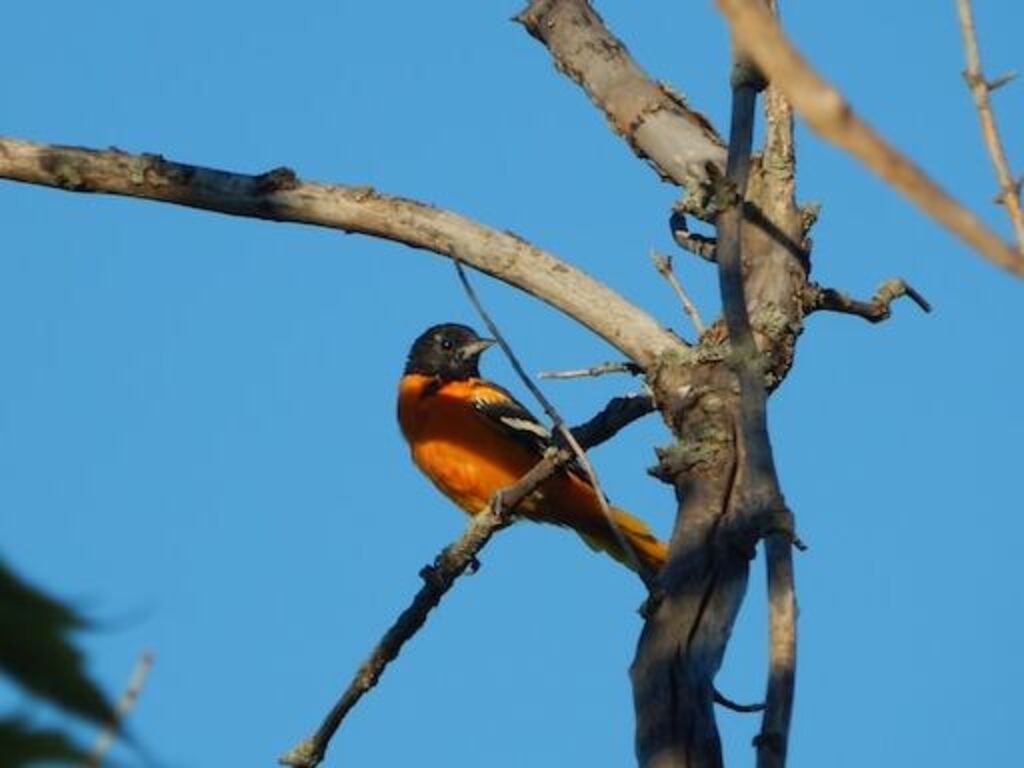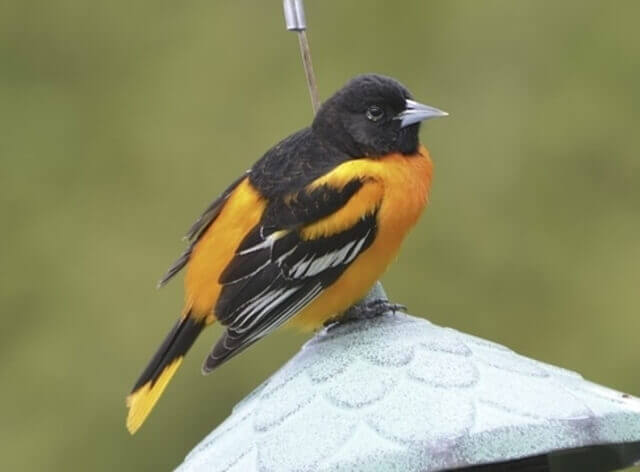Coincidences can often lead to fascinating discoveries, and for bird enthusiasts, spotting a male Baltimore Oriole can be one such coincidence.
With its vibrant orange plumage and intricate black markings, the male Baltimore Oriole is a striking sight to behold. What does a male Baltimore Oriole look like?
Native to North America, this bird species is known for its beautiful songs and unique nesting habits.
In this article, we will explore the physical characteristics of male Baltimore Orioles and how they differ from females. We will also discuss their habitat, diet, and migration patterns.
Finally, we will provide tips for spotting these magnificent birds in the wild, making it easier for bird watchers and nature lovers to catch a glimpse of the male Baltimore Oriole’s striking beauty.
Table of Contents
- 1 What Does A Male Baltimore Oriole Look Like?
- 2 Overview of the Baltimore Oriole Species
- 3 Physical Characteristics of Male Baltimore Orioles
- 4 Differences between Male and Female Baltimore Orioles
- 5 Habitat and Range of Male Baltimore Orioles
- 6 Diet and Feeding Habits
- 7 Behavioral Traits
- 8 Migration Patterns
- 9 Tips for Spotting Male Baltimore Orioles in the Wild
- 10 Frequently Asked Questions
- 10.1 How do male Baltimore Orioles mate and reproduce?
- 10.2 What is the lifespan of a male Baltimore Oriole?
- 10.3 Are there any predators that commonly prey on male Baltimore Orioles?
- 10.4 Do male Baltimore Orioles have any unique vocalizations or songs?
- 10.5 How do male Baltimore Orioles interact with other bird species in their habitat?
- 11 Conclusion
- 12 Author
What Does A Male Baltimore Oriole Look Like?
The male Baltimore Oriole is a visually stunning bird. It displays vibrant orange plumage with intricate black markings. Its body is slender, and it has a pointed bill and long wings.
The distinctive coloration sets it apart from the female, which has a more subdued yellowish hue. Keep an eye out for this striking bird with its eye-catching appearance when bird watching or exploring nature.

Overview of the Baltimore Oriole Species
The Baltimore Oriole species is a striking avian with bright plumage featuring vibrant orange and black feathers. These birds are known for their beautiful songs and can be found in various habitats throughout North America.
Baltimore Orioles are migratory birds that breed during the summer months in the eastern and central parts of the United States, as well as southern Canada.
Their breeding behaviors include building intricate hanging nests made of grasses, plant fibers, and other materials.
The male Baltimore Oriole is known for its loud and melodic songs, which are used to attract mates and defend their territory.
These birds are also known for their distinctive vocalizations, which include a series of whistles and chatters.
The physical characteristics of male Baltimore Orioles include a black head and wings, with a bright orange breast and underparts.
Their wingspan is typically around 9–12 inches, and they can weigh up to 1.5 ounces. With this overview in mind, let’s dive deeper into the physical characteristics of male Baltimore Orioles.
Physical Characteristics of Male Baltimore Orioles
The physical characteristics of the Baltimore Oriole’s male counterpart are distinct and easily recognizable.
Male Baltimore Orioles have bright orange plumage on their undersides, heads, and throats, with striking black wings and tails.
They also have a small white patch on their wings and a black mask around their eyes.
These plumage details are essential in attracting a mate during the breeding season, where males will display their bright colors and sing complex songs to attract females.
In addition to their physical characteristics, male Baltimore Orioles also exhibit specific breeding behaviors, such as building elaborate nests to impress and attract females.
These behaviors and physical attributes are unique to male Baltimore Orioles and allow them to thrive and reproduce in their natural habitat.
The differences between male and female Baltimore Orioles will be discussed in the subsequent section.
Differences between Male and Female Baltimore Orioles
Examining the distinctions between the physical characteristics and behaviors of male and female Baltimore Orioles provides insight into their reproductive strategies and survival tactics in their natural habitat.
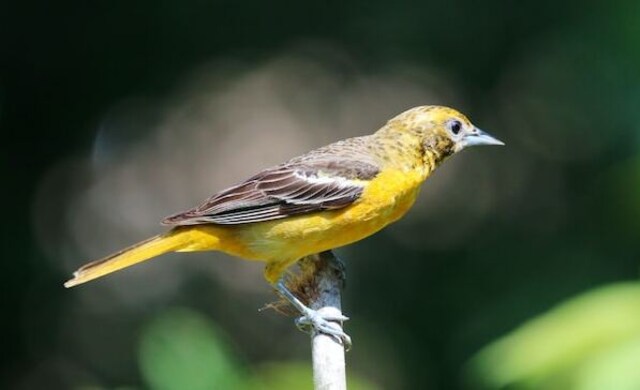
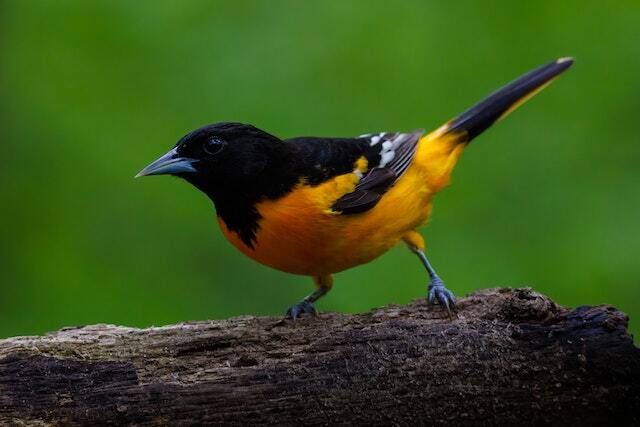
Male and female Baltimore Orioles have distinct differences in their plumage.
The male Baltimore Oriole has a vibrant orange body with black wings and a black head, while the female has a yellowish-green body with gray wings and a gray head.
The male’s colorful plumage is an example of sexual dimorphism, which helps attract a mate during breeding season.
Male Baltimore Orioles also exhibit unique breeding behaviors, such as singing elaborate songs and building intricate nests to impress their potential mate. In contrast, the female Baltimore Oriole is responsible for incubating the eggs and raising the young.
Understanding these differences in plumage and behavior can provide valuable insights into the reproductive strategies of Baltimore Orioles. Additionally, these differences can shed light on how they survive in their natural habitat, which includes deciduous forests, orchards, and suburban areas.
The next section will discuss the habitat and range of male Baltimore Orioles, providing further insight into their ecology and behavior.
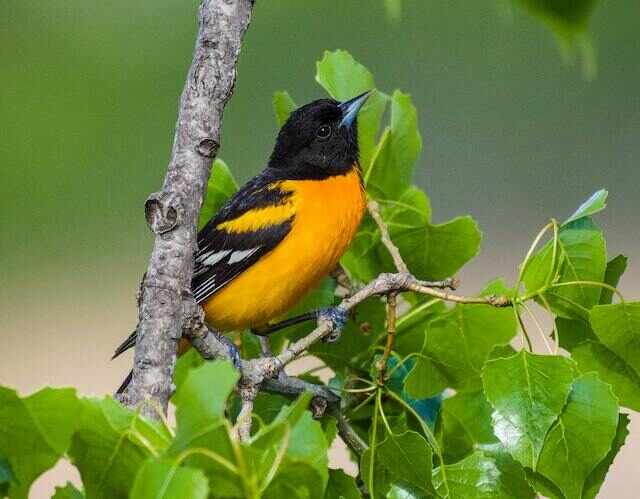
Habitat and Range of Male Baltimore Orioles
The ecological niche of the male Baltimore Oriole and its geographic range can be better understood by considering its habitat preferences, ranging from deciduous forests to suburban areas, and the conditions that promote survival and reproduction.
The male Baltimore Oriole is primarily found in the eastern and central regions of North America, including parts of Canada, the United States, and Mexico.
These birds are commonly found in open woodlands, forest edges, and parks with tall trees, where they build their nests in the upper branches.
Their nesting habits involve weaving a hanging basket-shaped nest that is suspended from the tips of tree branches.
Male Baltimore Orioles are known to be monogamous during the breeding season, and they remain fiercely territorial to protect their nests and offspring from potential predators.
The geographic distribution and nesting habits of male Baltimore Orioles are critical factors that influence their survival and breeding success.
In the subsequent section about ‘diet and feeding habits,’ we will explore how these birds acquire the necessary nutrients to thrive in their habitat.
Diet and Feeding Habits
Exploring the dietary and foraging habits of male Baltimore Orioles reveals their feeding preferences and nesting habits, shedding light on the complex web of life that sustains the natural world.
These birds primarily feed on insects, including beetles, caterpillars, and grasshoppers, but also consume nectar from flowers and fruits.
Orioles are known for their unique feeding behavior, in which they use their sharp beaks to pierce the skin of fruits to extract the juice inside.
They are also skilled hunters, using their long, pointed bills to capture prey in mid-air or from the ground.
Orioles construct intricate, hanging nests made of woven plant fibers and grasses, typically placed in the upper branches of trees.
The construction of these nests is a remarkable example of the bird’s behavioral traits, as males and females work together to build and maintain them.
The nesting habits of male Baltimore Orioles are an integral part of their ecological niche, providing shelter and protection for their offspring.
Understanding the diet and feeding habits of these birds not only illuminates their unique characteristics, but also highlights the importance of biodiversity in maintaining the delicate balance of the natural world.
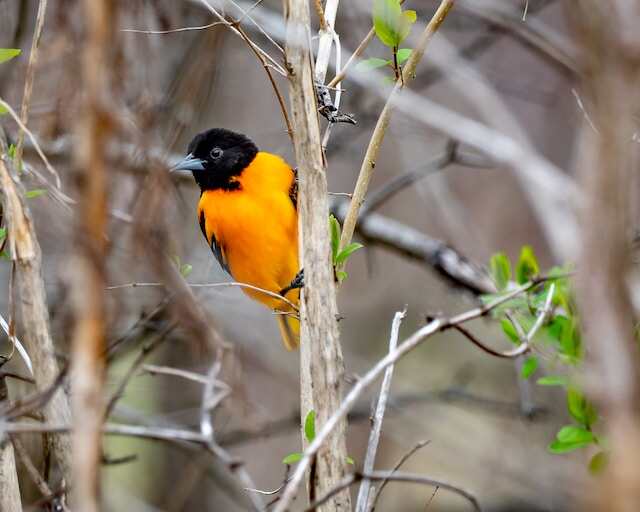
Behavioral Traits
This section delves into the intricate behavioral traits of Baltimore Orioles, shedding light on the complex interplay between their nesting habits, feeding preferences, and ecological niche.
Baltimore Orioles are known for their unique nesting habits, which involve weaving long, hanging nests from the tips of tree branches.
These nests serve to protect their young from predators and harsh weather conditions.
In addition, Baltimore Orioles are highly vocal birds, using a variety of calls and songs to communicate with each other and establish their territory.
Their feeding habits are also notable, as they primarily feed on insects and nectar, with a preference for ripe fruit.
These behavioral traits are essential for the survival and reproduction of Baltimore Orioles, allowing them to adapt to their environment and thrive in their ecological niche.
As we move onto the next section about migration patterns, it’s important to note that these behavioral traits play a crucial role in the birds’ ability to navigate long distances and find suitable habitats throughout the year.
Migration Patterns
Migration patterns of the male Baltimore Oriole involve both timing and routes. These birds migrate from their breeding grounds in North America to their wintering grounds in Central America and northern South America.
Conservation efforts have been implemented to ensure the survival of these birds during their long and arduous journey, including habitat preservation and monitoring of migration routes.
Timing and Routes
The timing and routes of the Baltimore oriole’s migration are crucial to understanding its behavior and ecological role, as evidenced by the significant impact it has on the ecosystems it inhabits.
These birds typically migrate twice a year, with their breeding season being the primary driver of their movements.
In the spring, male orioles will arrive at their breeding grounds in the eastern United States, while females will follow shortly after.
During the fall migration, Baltimore Orioles will move south towards Central America and the Caribbean, where they will spend the winter months.
The exact routes taken by these birds during migration are still not fully understood, but it is believed that they follow a pattern of coastal migration with stopovers at specific locations along the way.
Conservation efforts for the Baltimore oriole must take into account their migration routes and breeding season, as any disturbances to these crucial periods could have significant impacts on their survival and the ecosystems they rely on.
Conservation Efforts
One important aspect of conservation efforts for the Baltimore oriole involves understanding and addressing human-caused threats that negatively impact their population and ecosystem role.
Conservation strategies include habitat restoration, pesticide reduction, and addressing climate change.
Community involvement is also crucial in the success of conservation efforts.
Citizen science programs, such as the Great Backyard Bird Count, allow individuals to report sightings of Baltimore Orioles and contribute to the understanding of their distribution and population trends.
Additionally, creating bird-friendly landscapes with native plants can provide essential habitat and food sources for these birds.
By taking action to address these threats and engaging with the community, we can work towards ensuring the survival and thriving of the Baltimore oriole population.
In the next section, we will discuss tips for spotting male Baltimore orioles in the wild.
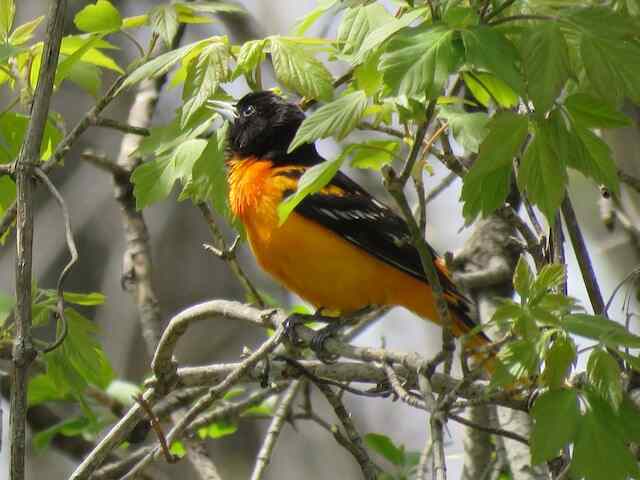
Tips for Spotting Male Baltimore Orioles in the Wild
When identifying Baltimore Orioles in their natural habitat, it is helpful to observe their prominent black and orange plumage, as well as their distinctive shape and behavior.
The male Baltimore Oriole has a bright orange breast and underparts, contrasting sharply with its black head, wings, and back.
Additionally, the male has a distinctive black eye line that extends from its beak to the back of its head.
The female, on the other hand, is more subdued in color with an olive-brown back and grayish-white underparts.
Orioles are most active during the early morning and late afternoon hours, making these the best times to spot them.
They can often be seen flitting from branch to branch in search of insects, their primary source of food.
With a little patience and observation, one can easily spot and identify male Baltimore Orioles in the wild.
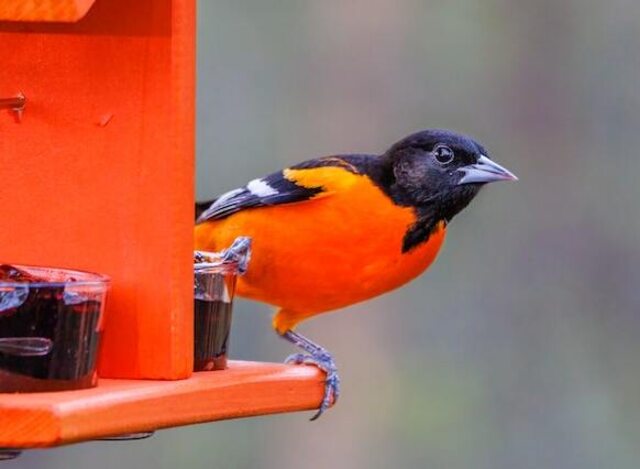
Frequently Asked Questions
How do male Baltimore Orioles mate and reproduce?
Male Baltimore orioles are known for their impressive breeding behavior and courtship rituals. These birds engage in elaborate displays that involve singing, flapping their wings, and even offering food to females.
During the mating season, males will also engage in territorial behavior to defend their chosen breeding ground.
The courtship rituals of male Baltimore Orioles are a sight to behold, with their bright orange plumage and striking black markings standing out against the green foliage.
This breeding behavior is a fascinating example of the intricate and complex mating strategies that exist in the animal kingdom.
Understanding the courtship rituals of Baltimore Orioles can offer insights into the evolution of mating behavior and how it contributes to the survival of species.
What is the lifespan of a male Baltimore Oriole?
The lifespan of a male Baltimore Oriole can vary depending on a number of factors, including habitat, food availability, and predation rates. However, on average, they tend to live for around 4-5 years in the wild.
These birds are known for their impressive migration patterns, which can extend from Central America all the way up to the northeastern United States and southeastern Canada.
During the breeding season, males typically establish territories and court females through a series of displays and songs.
Once a pair has mated, they will build a nest together and raise their young until they are ready to fledge.
Overall, the lifespan facts and migration patterns of male Baltimore Orioles provide fascinating insights into the natural history of these remarkable birds.
Are there any predators that commonly prey on male Baltimore Orioles?
Male Baltimore Orioles are preyed upon by a number of common predators in their natural habitats, including hawks, owls, jays, and snakes.
These predators are known to target orioles during their nesting season, when the birds are particularly vulnerable due to their increased activity levels and conspicuous behavior.
Female orioles are also at risk during this time, as they spend a significant amount of time incubating eggs and caring for their young.
To avoid predation, orioles have developed a number of nesting habits that help them to remain hidden from their enemies.
This includes building their nests in trees with dense foliage, and using materials such as spider webs and lichen to camouflage the nest from view.
Despite these measures, however, predation remains a significant threat to the survival of male Baltimore orioles and other bird species in the wild.
Do male Baltimore Orioles have any unique vocalizations or songs?
Baltimore oriole vocalizations are an integral part of their breeding behavior. Males are known for their distinct songs, which are characterized by their clear, whistling notes and melodious trills.
These songs are used to attract females and defend their territory from other males.
Interestingly, male orioles also incorporate mimicry into their songs, imitating the calls of other bird species. This adds a layer of complexity to their vocalizations, making them unique and impressive.
Overall, the vocalizations of male Baltimore orioles are an important aspect of their breeding behavior and are sure to captivate any listener with their intricate melodies and impressive mimicry.
How do male Baltimore Orioles interact with other bird species in their habitat?
Male Baltimore Orioles are known for their distinctive social behavior and nest building skills. These birds exhibit a high level of territoriality, often fiercely defending their nests against other bird species.
However, they do occasionally interact with other species in their habitat, such as chickadees and blue jays, particularly during the breeding season.
Male Baltimore Orioles spend a significant amount of time building nests, which are intricately woven structures made of plant fibers, hair, and other materials.
They often work in pairs, with the male collecting materials and the female weaving them together.
This behavior is not only essential for their survival but also serves as an impressive display of their innate skills and creativity.
Overall, the social behavior and nest building abilities of male Baltimore Orioles make them fascinating subjects for scientific study and observation.
Conclusion
The Baltimore Oriole species is known for its bright and striking colors, with the male being especially vibrant. Males have a bright orange-yellow body with black wings, tail, and head.
They also have a black throat and white wing bars. In contrast, females have a duller yellow-orange body with grayish-brown wings and tail.
Male and female Baltimore Orioles also differ in size, with males being slightly larger than females.
These birds are commonly found in open woodlands, parks, and gardens across the eastern United States and southern Canada.
They primarily feed on insects, fruit, and nectar, and can be spotted singing and foraging in trees.
Baltimore Orioles are known for their unique behaviors such as weaving intricate hanging nests and their distinct migratory patterns.
In the fall, they travel to Central and South America, returning to their breeding grounds in the spring.
To spot a male Baltimore Oriole in the wild, look for their bright colors and listen for their beautiful songs.
As the saying goes, ‘the early bird catches the worm,’ so it’s best to observe them in the morning when they are most active.
Overall, the male Baltimore Oriole is a stunning bird to observe, with its striking colors and unique behaviors.

